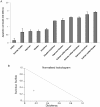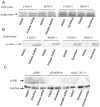Combinatorial effect of non-steroidal anti-inflammatory drugs and NF-κB inhibitors in ovarian cancer therapy
- PMID: 21931671
- PMCID: PMC3171406
- DOI: 10.1371/journal.pone.0024285
Combinatorial effect of non-steroidal anti-inflammatory drugs and NF-κB inhibitors in ovarian cancer therapy
Abstract
Several epidemiological studies have correlated the use of non-steroidal anti-inflammatory drugs (NSAID) with reduced risk of ovarian cancer, the most lethal gynecological cancer, diagnosed usually in late stages of the disease. We have previously established that the pro-apoptotic cytokine melanoma differentiation associated gene-7/Interleukin-24 (mda-7/IL-24) is a crucial mediator of NSAID-induced apoptosis in prostate, breast, renal and stomach cancer cells. In this report we evaluated various structurally different NSAIDs for their efficacies to induce apoptosis and mda-7/IL-24 expression in ovarian cancer cells. While several NSAIDs induced apoptosis, Sulindac Sulfide and Diclofenac most potently induced apoptosis and reduced tumor growth. A combination of these agents results in a synergistic effect. Furthermore, mda-7/IL-24 induction by NSAIDs is essential for programmed cell death, since inhibition of mda-7/IL-24 by small interfering RNA abrogates apoptosis. mda-7/IL-24 activation leads to upregulation of growth arrest and DNA damage inducible (GADD) 45 α and γ and JNK activation. The NF-κB family of transcription factors has been implicated in ovarian cancer development. We previously established NF-κB/IκB signaling as an essential step for cell survival in cancer cells and hypothesized that targeting NF-κB could potentiate NSAID-mediated apoptosis induction in ovarian cancer cells. Indeed, combining NSAID treatment with NF-κB inhibitors led to enhanced apoptosis induction. Our results indicate that inhibition of NF-κB in combination with activation of mda-7/IL-24 expression may lead to a new combinatorial therapy for ovarian cancer.
Conflict of interest statement
Figures





Similar articles
-
A novel pathway involving melanoma differentiation associated gene-7/interleukin-24 mediates nonsteroidal anti-inflammatory drug-induced apoptosis and growth arrest of cancer cells.Cancer Res. 2006 Dec 15;66(24):11922-31. doi: 10.1158/0008-5472.CAN-06-2068. Cancer Res. 2006. PMID: 17178890
-
Parthenolide and sulindac cooperate to mediate growth suppression and inhibit the nuclear factor-kappa B pathway in pancreatic carcinoma cells.Mol Cancer Ther. 2005 Apr;4(4):587-94. doi: 10.1158/1535-7163.MCT-04-0215. Mol Cancer Ther. 2005. PMID: 15827332
-
The non-steroidal anti-inflammatory drugs Sulindac sulfide and Diclofenac induce apoptosis and differentiation in human acute myeloid leukemia cells through an AP-1 dependent pathway.Apoptosis. 2011 Sep;16(9):889-901. doi: 10.1007/s10495-011-0624-y. Apoptosis. 2011. PMID: 21739277
-
Medicinal Plants in Cancer Treatment: Contribution of Nuclear Factor- Kappa B (NF-kB) Inhibitors.Mini Rev Med Chem. 2022;22(15):1938-1962. doi: 10.2174/1389557522666220307170126. Mini Rev Med Chem. 2022. PMID: 35260052 Review.
-
Recent insights into apoptosis and toxic autophagy: The roles of MDA-7/IL-24, a multidimensional anti-cancer therapeutic.Semin Cancer Biol. 2020 Nov;66:140-154. doi: 10.1016/j.semcancer.2019.07.013. Epub 2019 Jul 26. Semin Cancer Biol. 2020. PMID: 31356866 Free PMC article. Review.
Cited by
-
Perspectives of pharmacological treatment in otosclerosis.Eur Arch Otorhinolaryngol. 2013 Mar;270(3):793-804. doi: 10.1007/s00405-012-2126-0. Epub 2012 Jul 29. Eur Arch Otorhinolaryngol. 2013. PMID: 22843095 Review.
-
ROS-Mediated Necrosis by Glycolipid Biosurfactants on Lung, Breast, and Skin Melanoma Cells.Front Oncol. 2021 Mar 16;11:622470. doi: 10.3389/fonc.2021.622470. eCollection 2021. Front Oncol. 2021. PMID: 33796459 Free PMC article.
-
The efficacy of combination therapy using adeno-associated virus-mediated co-expression of apoptin and interleukin-24 on hepatocellular carcinoma.Tumour Biol. 2013 Oct;34(5):3027-34. doi: 10.1007/s13277-013-0867-z. Epub 2013 Aug 2. Tumour Biol. 2013. PMID: 23907578
-
Insights Into the Regulation of Gynecological Inflammation-Mediated Malignancy by Metalloproteinases.Front Cell Dev Biol. 2021 Nov 29;9:780510. doi: 10.3389/fcell.2021.780510. eCollection 2021. Front Cell Dev Biol. 2021. PMID: 34912809 Free PMC article. Review.
-
Conservative Otosclerosis Treatment With Sodium Fluoride and Other Modern Formulations: A Systematic Review.Cureus. 2023 Feb 10;15(2):e34850. doi: 10.7759/cureus.34850. eCollection 2023 Feb. Cureus. 2023. PMID: 36923175 Free PMC article. Review.
References
-
- Jemal A, Siegel R, Ward E, Hao Y, Xu J, et al. Cancer statistics, 2008. CA Cancer J Clin. 2008;58:71–96. - PubMed
-
- Tingulstad S, Skjeldestad FE, Halvorsen TB, Hagen B. Survival and prognostic factors in patients with ovarian cancer. Obstet Gynecol. 2003;101:885–891. - PubMed
-
- Berkel H, Holcombe RF, Middlebrooks M, Kannan K. Nonsteroidal antiinflammatory drugs and colorectal cancer. Epidemiol Rev. 1996;18:205–217. - PubMed
-
- Coogan PF, Rao SR, Rosenberg L, Palmer JR, Strom BL, et al. The relationship of nonsteroidal anti-inflammatory drug use to the risk of breast cancer. Prev Med. 1999;29:72–76. - PubMed
-
- Cramer DW, Harlow BL, Titus-Ernstoff L, Bohlke K, Welch WR, et al. Over-the-counter analgesics and risk of ovarian cancer. Lancet. 1998;351:104–107. - PubMed
Publication types
MeSH terms
Substances
Grants and funding
LinkOut - more resources
Full Text Sources
Medical
Research Materials

